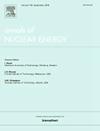Advanced full-core modeling of fission product release in pebble-bed high-temperature gas-cooled reactors
IF 2.3
3区 工程技术
Q1 NUCLEAR SCIENCE & TECHNOLOGY
引用次数: 0
Abstract
Accurate modeling of fission product release is essential for the safety of pebble-bed high-temperature gas-cooled reactors. Traditional models oversimplify by neglecting non-uniform temperature fields, variable nuclide production rates, and the randomness of pebble flow. This study introduces an enhanced diffusion calculation method that incorporates variable production rates from the burnup equation and non-uniform temperature profiles from steady-state heat conduction models. A rapid full-core release calculation refined to individual pebble dynamics is developed to better capture equilibrium core behavior. Comparing the refined model to traditional methods, results show stepwise accumulation of concentrations, reduced release rates from particles and pebbles, and increased concentration gradients within the graphite matrix. Release rate distributions for short-lived nuclides are influenced by both core temperature and neutron flux distributions, while those for long-lived nuclides are primarily temperature-dependent. The variable-temperature model indicates that, compared to uniform particle temperature models, a greater diffusion distance is required for nuclide release.
球床高温气冷堆裂变产物释放的先进全堆芯模型
准确的裂变产物释放模型对球床高温气冷堆的安全性至关重要。传统模型由于忽略了非均匀温度场、可变核素产生率和卵石流动的随机性而过于简化。本研究引入了一种改进的扩散计算方法,该方法结合了燃耗方程的可变产率和稳态热传导模型的非均匀温度分布。为了更好地捕捉岩心平衡行为,开发了一种针对单个卵石动力学的快速全岩心释放计算方法。将改进后的模型与传统方法进行比较,结果显示浓度逐步积累,颗粒和卵石的释放速率降低,石墨基体内浓度梯度增大。短寿命核素的释放速率分布受堆芯温度和中子通量分布的影响,而长寿命核素的释放速率分布主要受温度的影响。变温模型表明,与均匀粒子温度模型相比,核素释放需要更大的扩散距离。
本文章由计算机程序翻译,如有差异,请以英文原文为准。
求助全文
约1分钟内获得全文
求助全文
来源期刊

Annals of Nuclear Energy
工程技术-核科学技术
CiteScore
4.30
自引率
21.10%
发文量
632
审稿时长
7.3 months
期刊介绍:
Annals of Nuclear Energy provides an international medium for the communication of original research, ideas and developments in all areas of the field of nuclear energy science and technology. Its scope embraces nuclear fuel reserves, fuel cycles and cost, materials, processing, system and component technology (fission only), design and optimization, direct conversion of nuclear energy sources, environmental control, reactor physics, heat transfer and fluid dynamics, structural analysis, fuel management, future developments, nuclear fuel and safety, nuclear aerosol, neutron physics, computer technology (both software and hardware), risk assessment, radioactive waste disposal and reactor thermal hydraulics. Papers submitted to Annals need to demonstrate a clear link to nuclear power generation/nuclear engineering. Papers which deal with pure nuclear physics, pure health physics, imaging, or attenuation and shielding properties of concretes and various geological materials are not within the scope of the journal. Also, papers that deal with policy or economics are not within the scope of the journal.
 求助内容:
求助内容: 应助结果提醒方式:
应助结果提醒方式:


